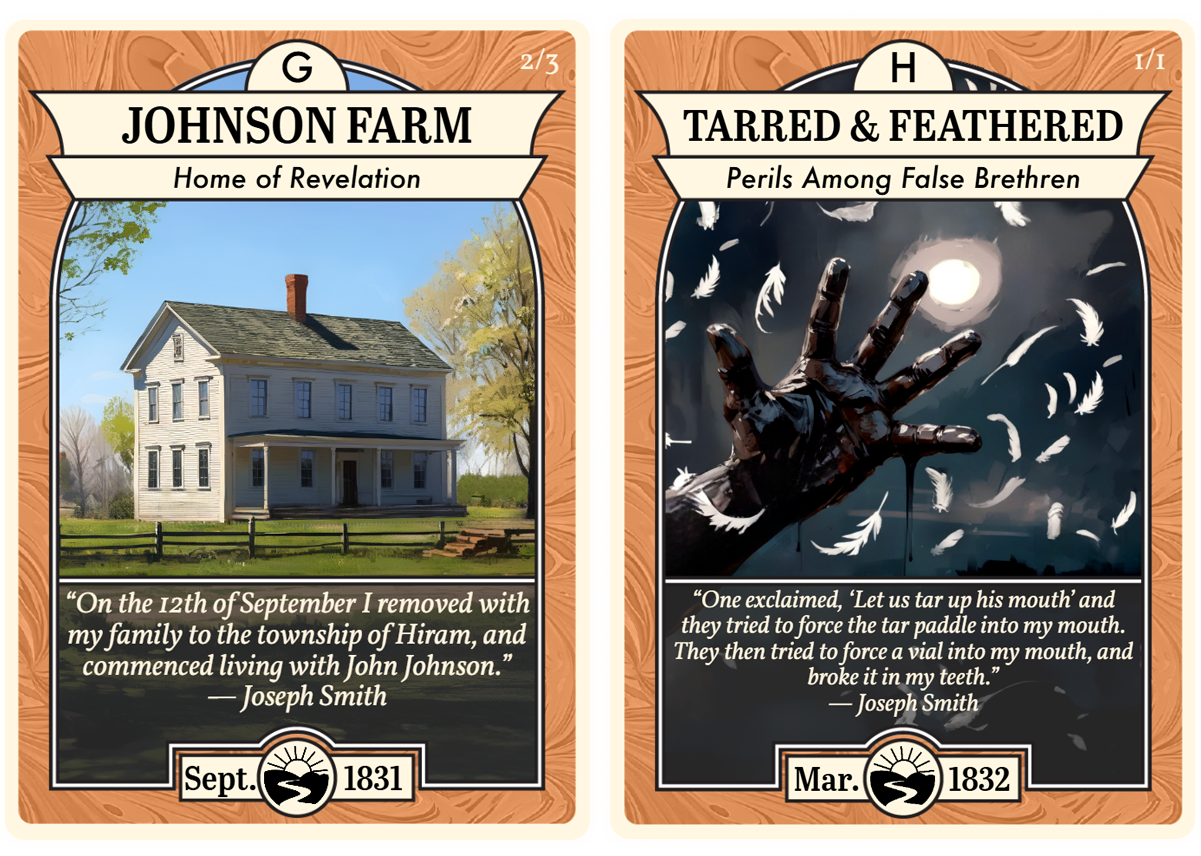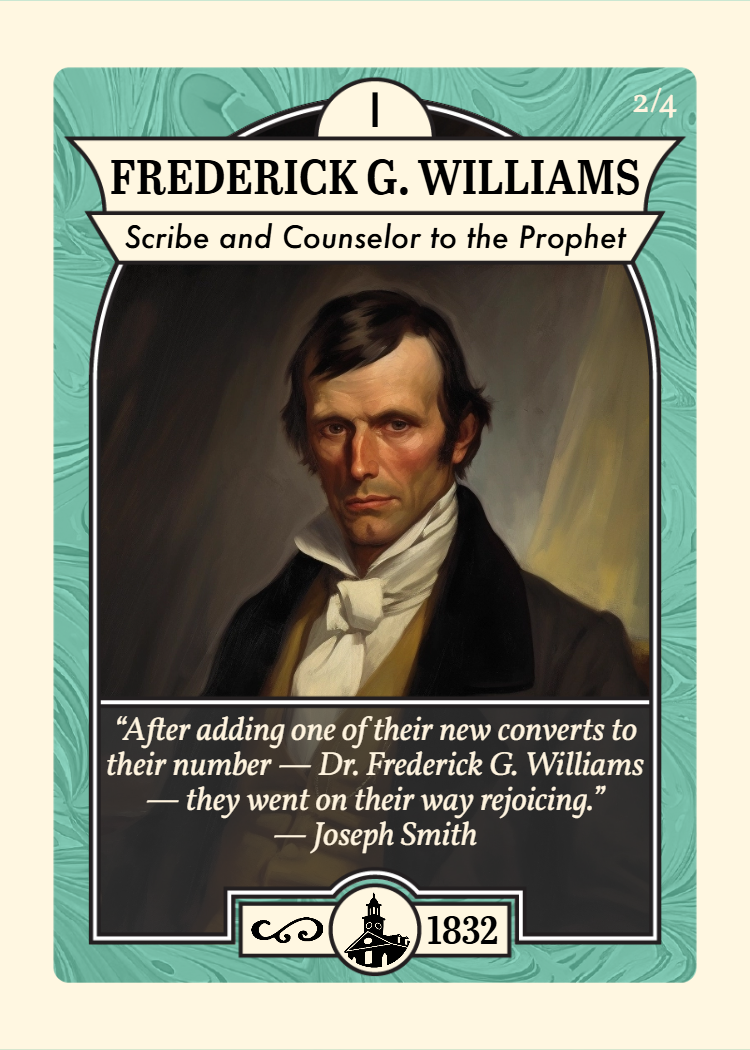For a few key months in Church history, nearly everything seemed to happen in one Ohio farmhouse.
In the Johnson home in Hiram, Joseph Smith received revelation after revelation, worked on the New Testament translation, and recorded one of the most theologically expansive moments of the Restoration: a revelation known as "The Vision," now recorded in Doctrine and Covenants 76. What he and Sidney Rigdon saw in that upstairs room would forever change how Latter-day Saints understood heaven, salvation, and the eternal destiny of God’s children.
But the peace didn’t last. A violent mob attack, fueled by growing opposition to Joseph’s influence and revelations, left both Joseph and Sidney physically battered. Even then, the work pressed forward, supported by faithful Saints like Frederick G. Williams, who quietly stepped into leadership roles when it mattered most.
A House of Revelation: Johnson Farm and Tarred & Feathered

In September 1831, Joseph and Emma Smith moved into the farmhouse of John and Elsa Johnson in Hiram, Ohio, about thirty miles south of Kirtland. The Johnsons, once members of Ezra Booth’s Methodist congregation, had joined the Church following the sudden healing of Elsa’s chronic arm condition, an event that briefly converted Booth as well.
The Johnson home, large and well-kept, quickly became a base of operations for the Prophet. Over the next year, Joseph received at least sixteen revelations in the house, most of which are now part of the Doctrine and Covenants. He also continued work on his inspired translation of the Bible, often in collaboration with Sidney Rigdon.
Life in Hiram wasn’t quiet for long. Tensions had been rising in Ohio over Joseph Smith’s growing influence, his revelations, and rumors about the Church’s teachings and practices. One March evening, a mob stormed the Johnson home, pulled Joseph from his bed, and dragged him into a nearby field, beat him, stripped him, and covered him in tar and feathers. They tried to force acid into his mouth, chipping a tooth in the process. Sidney Rigdon was also assaulted and left with serious head injuries. Emma stayed behind to care for their adopted twins, one of whom would die shortly after the attack, and then tended to Joseph’s injuries.
Despite the trauma, Joseph preached a sermon the very next day from the Johnsons’ front steps and baptized three converts. Sidney, however, remained delirious for days.
Even amid the instability and violence, revelation continued. Just a few weeks earlier, in that same upstairs room, Joseph and Sidney had received a vision that would redefine Latter-day Saint theology.
Surpass All Understanding: The Vision
![Church History Card titled “The Vision – Three Degrees of Glory,” dated February 1832. The artwork shows a stylized sun, moon, and stars representing the celestial, terrestrial, and telestial kingdoms, inspired by Doctrine and Covenants 76. The quote reads: “The mysteries of [God’s] kingdom which he showed unto us… surpass all understanding in glory.” — Joseph Smith and Sidney Rigdon.](/cdn-cgi/image/f=auto,fit=scale-down,w=3840,h=1050/files/0PNPTm/img-1b2bdbc2-55f0-45cf-9ee7-b6838c4b69c6.png?t=eyJhbGciOiJkaXIiLCJlbmMiOiJBMjU2R0NNIn0..5OrB4D3BxBym87Uh.RCzC4wkZDOuYicgUX5fsybZF7_xamB-mJyGVva40kVX8Ja02mK0oxIs8YpCriSEH02QME7sqPzM35EascpV7lNa_F6j2UKilyY1dCpdFuDscmsyxbu4use_GvlR5nVFlmulHuc26vcV3ehmyjUZ_29Fx6GTnFBWN1mRMwgp-cuq4OIr7qMp4GY4Nxrr5WqHNJlDhE3QlZOb63oupxq78Z1Lxp3pbMfeOW9sajNCcLOhB61s4gbNTiyKznQj4RLQbggjBYRXN5Nw8ddYavqCvjBHXtkUtuGJVqashu08hIFnxpPS8WVQGBsFxrO1drXAf-7RDoEE2bcB-WyBrN-ELMTzbBC39Tz2pHuVY5UfogMNRHCrsYuKtaUjNcfmB6AyjICmIVNIzuO8F5tqDt3L3TCRoG-0.KAIyDqEEv7ISs6GlWGXLtA)
In February 1832, while working on the New Testament translation upstairs in the Johnson home, Joseph Smith and Sidney Rigdon paused on a verse in John 5 that spoke of the resurrection of the just and unjust. That single verse opened into a vision, which Joseph later described simply as "The Vision," that would forever change how Latter-day Saints understood the afterlife.
According to eyewitness accounts, Joseph and Sidney spoke aloud as the vision progressed, taking turns describing what they saw. The two men described being shown a structured afterlife with three degrees of glory—celestial, terrestrial, and telestial—and learned that all people, through Jesus Christ, would rise in the Resurrection.
The content of the vision marked a dramatic departure from the binary heaven-or-hell theology common in 19th-century Christianity. Some welcomed the expanded view of salvation with relief and joy. Others found it troubling or confusing, particularly the idea that so many would receive some degree of glory. The vision was first published in The Evening and the Morning Star and later canonized as Doctrine and Covenants 76.
Though it wasn’t universally accepted at first, The Vision became one of the defining revelations of the Restoration, reshaping how Latter-day Saints understood the nature of God, grace, and the eternal destiny of humankind.
From Convert to Counselor: Frederick G. Williams

While The Vision unfolded upstairs in the Johnson home, others were quietly helping move the work forward. One of them was Frederick Granger Williams: a doctor by training and a recent convert to the Church.
In late 1830, not long after his baptism, Williams joined Oliver Cowdery and a small group of missionaries heading west to preach to Native American tribes. Known at the time as a mission to the Lamanites, the journey took them across snowy plains and frozen rivers all the way to the edge of the American frontier in Missouri. Williams, the oldest in the group, endured the physical hardship with the same quiet steadiness he would bring to later Church assignments.
By 1832, he had become one of Joseph Smith’s scribes, assisting in recording revelations and helping with the ongoing translation of the Bible. The following year, when Jesse Gause, originally called to the First Presidency, left the Church, Frederick was named his replacement. In the original manuscript of the revelation now known as Doctrine and Covenants 81, Gause’s name was crossed out and Williams’ written in. He was ordained in March 1833.
Though less visible than some of his contemporaries, Frederick G. Williams became a central figure during this formative period. His combination of experience, loyalty, and willingness to serve helped anchor the Church as it continued to grow and change.
Learn more (and get your own set of cards) at churchhistorycards.com.
Bonus Trivia
*Answers in footnotes
1. How many sections of the Doctrine and Covenants were received at the Johnson farm?[1]
A. 3 B. 11 C. 16 D. 21
2. What were Joseph Smith and Sidney Rigdon working on when they received “The Vision”?[2]
A. Teaching in the School of the Prophets B. Praying about tithing C. Writing a sermon D. Translating the Bible
3. What special training did Frederick G. Williams have?[3]
A. He was an engineer B. He was a doctor C. He was an artillery expert D. He spoke 5 languages


